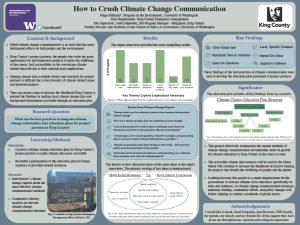HOW TO CRUSH CLIMATE CHANGE COMMUNICATION
Without adequate climate change communication, it is impossible to unite our diverse society in solving equally diverse and threatening issues relating to the climate crisis. Climate change risks are only becoming more prevalent, and the way in which we educate and empower one another will be detrimental towards climate stability. The purpose of this study was to reveal the most effective methodology of climate change communication for both the project partners in King County and the greater community. Through my internship with King County, I created a climate change education plan for King County’s project partners, who oversee the drafting of national grant applications for projects directly related to climate issues. Simultaneously, by interviewing five climate experts and completing a literature review, I researched major themes in successful climate change communication to implement in the education plan. According to experts and the literature, the inclusion of clear and simple visual aids, an optimistic tone or solutions, the space for questions, local and specific evidence, the repetition of key ideas, and the use of storytelling were highlighted as essential. By incorporating these themes into the education plan, the presentation is more accessible, increasing the likelihood that project partners will receive the funding for King County projects that benefit the wellbeing of the greater Seattle area. More generally, these results help climate change communicators ensure they are informing well, further empowering individuals to cause a great multitude of environmental and societal benefits.
